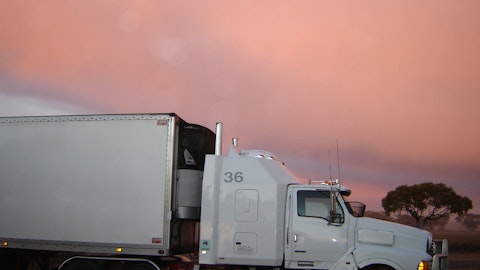Covenant Logistics Group, Inc. (NASDAQ:CVLG) Q4 2023 Earnings Call Transcript January 24, 2024
Covenant Logistics Group, Inc. isn’t one of the 30 most popular stocks among hedge funds at the end of the third quarter (see the details here).
Operator: Welcome to today’s Covenant Logistics Group Fourth Quarter Earnings Release Conference Call. Our host for today’s call is Tripp Grant. At this time, all participants will be in a listen-only mode. Later, we will conduct a question-and-answer session. I would now like to turn the call over to your host. Mr. Grant, you may begin.
Tripp Grant: Good morning, everyone, and welcome to the Covenant Logistics Group’s fourth quarter 2023 conference call. As a reminder, this call will contain forward-looking statements under the Private Securities Litigation Reform Act, which are subject to risks and uncertainties that could cause actual results to differ materially. Please review our SEC filings and most recent risk factors. We undertake no obligation to publicly update or revise any forward-looking statements. A copy of the prepared comments or additional financial information is available on our website at www.covenantlogistics.com/investors. I’m joined on the call today by David Parker, and Paul Bunn. Before we address the fourth quarter’s results, I’d like to take a moment to reflect on the year as a whole.
As challenging as it was, 2023 was a pivotal year for Covenant. We were able to demonstrate the durability of our improved business model by achieving the second-best adjusted earnings per share in company history while setting the stage for future growth and improvement through the accretive acquisitions of Lew Thompson and Son Trucking and Sims Transport. These achievements would not have been possible without the commitment from our talented people and many years of planning, execution and collaborative teamwork. As we enter 2024, we do so with a resolved commitment to forward progress on our strategic long-term plan and improving upon these results in the future. Focusing now on the quarter, we were pleased with our fourth quarter’s results despite the lingering weakness in the overall freight environment.
Compared to a year ago, consolidated freight revenue was down approximately $15.3 million or 6% primarily as a result of year-over-year tractor count and rate declines in our asset-based truckload businesses, combined with little to no overflow freight handled by our asset-light Managed Freight segment, partially offset by improved utilization of our assets. Adjusted operating income declined approximately $4.9 million or 22% compared to the prior year quarter, primarily resulting from a $6.1 million decrease in our Managed Freight segment, partially offset by a $1.2 million improvement to the profitability of our Warehousing segment, while the combined truckload operations were essentially flat. Adjusted net income decreased 24% to $14.8 million and adjusted earnings per share decreased 22% to $1.07 per share compared to the year ago quarter.
Weighted average diluted shares decreased approximately 3.5% because of our share repurchase program. Key highlights include, despite 9% rate declines and 4% average tractor count reductions, our combined truckload operations generated roughly the same adjusted operating income in the fourth quarter of 2023 as they did in 2022. The Lew Thompson and Son Trucking operation continues to perform well with near-term opportunities to meaningfully grow the business in the first quarter of 2024. Our net capital investment for revenue producing equipment was approximately $91 million for the quarter, consisting of approximately $48 million in normal 2023 replacement CapEx, $13 million in specialized equipment CapEx for poultry related growth, and $30 million in pull forward of normal replacement CapEx originally scheduled for 2024.
The average age of our fleet at December 31st improved to 19 months compared to 26 months in the prior year and 23 months at September 30, 2023. Within our combined truckload segments, compared to the prior year, operations and maintenance-related expenses declined by $0.11 per total mile or 38% and fixed equipment-related costs, including leased revenue equipment expenses, depreciation, and gains on sale only increased $0.04 per total mile. Gain on sale of revenue equipment was $0.2 million in the quarter, compared to $1 million in the prior year. Declining fuel prices and lagging fuel surcharge recovery rates created a tailwind for our combined truckload operations, which helped us overcome the negative impact of a cyber event with a major customer and the United Auto Workers strike in the quarter.
Our TEL leasing company investment produced $0.25 per diluted share, compared to $0.21 per diluted share versus the year ago period. Our net indebtedness as of December 31st was $248.3 million, yielding an adjusted leverage ratio of approximately 2 times and debt-to-capital ratio of 38.1%, On an adjusted basis, return on invested capital was 8.9% for the current quarter versus 17.7% in the prior year. The decline is attributable to reduced year-over-year operating income, particularly from our asset-light Managed Freight segment and the increase in the average invested capital base associated with acquisitions, growth CapEx and pulling equipment purchases forward. Now, Paul will provide a little more color on the items affecting the individual business segments.

Paul Bunn: Thanks Tripp. Expedited outperformed our expectations during the fourth quarter, yielding a 91.4% adjusted operating ratio. The negative impact of a cyber attack on a major customer in the quarter was largely offset by the benefits of fuel recovery lagging a declining DOE price. In this segment, rates have decline by approximately 12%, but utilization has improved approximately 5%. The improvement in utilization was principally attributable to more engineered routes and newer equipment in the fleet with less down time. Dedicated reflected another success story, yielding a 91.4% adjusted operating ratio also representing our best quarterly results for this segment in company history. Similar to Expedited, our Dedicated operations saw a positive impact to profitability as a result of declining fuel prices, offsetting the negative impact of the United Auto Workers strike in the quarter.
Over the past three years, we have worked hard to improve the profitability within this segment by exiting unprofitable business and adding more profitable business. This weed and feed approach has been clunky at times, but has served us well in deploying capital towards opportunities that meet our profitability and return requirements. We are pleased with the year-over-year improvement to adjusted margin and expect to continue to improve upon this segment’s size and profitability over the long-term. Managed Freight experienced a15% reduction of total freight revenue and a 69% reduction of consolidated adjusted operating profit. The significant reduction in revenue and operating profit was primarily the product of little to no high-margin overflow freight from our asset-based Truckload segments.
Nevertheless, the asset-light nature of the business still generates an acceptable return on invested capital at the 95.8% adjusted operating ratio which was achieved in the fourth quarter. The brokerage environment remains highly competitive with numerous brokers aggressively competing for volumes at the expense of margin. We anticipate continued margin pressure in this environment. Our Warehouse segment saw a 16% increase in freight revenue and a 428% increase of adjusted operating profit compared to the prior year, as a result of the combination of new customer startups and rate increases with existing customers over the last 12 months. Although, we were pleased with the improved profitability within this segment, we will continue to focus on improving profitability through improved labor utilization and rate increases with existing customers.
Our minority investment in TEL contributed pre-tax net income of $4.7 million for the quarter, compared to $3.9 million in the prior year period. The increase was largely due to suppressed 2022 earnings resulting from increased depreciation in 2022 taken on certain high-mileage tractors that were being prepared to sell. TEL’s revenue in the quarter declined 14% and pre-tax income increased by approximately 20% versus the fourth quarter of 2022. TEL decreased its truck fleet in the quarter versus year ago by 106 trucks to 2,131 and reduced its trailer fleet by 339 to 6,810. Due to the business model, gains and losses on sale of equipment is a normal part of the business and can cause earnings to fluctuate from quarter-to-quarter. Our investment in TEL, included in Other Assets on our consolidated balance sheet, has grown to $66.3 million as of December 31, 2023, from our original investment of $4.9 million.
In 2022, we received $14.7 million in cash dividends from TEL, and we received $9.8 million in 2023. Regarding our outlook for the future: 2023 provided as challenging of a freight environment as we have experienced in years but we were extremely pleased with the performance of the model and team. This is a different team and a different model than “the Covenant” of five to 10 years ago. As it relates to 2024, we see no immediate macroeconomic or industry catalyst, but believe continuing to execute on our strategic plan and capacity attritions from the market will result in incremental improvements to operating conditions throughout 2024. As a result, we believe we can surpass our 2023 results with higher adjusted earnings per share and greater free cash flow that will allow us to reduce our net indebtedness and/or exercise other capital allocation alternatives.
Thank you for your time. We will now open up the call for questions.
Operator: [Operator Instructions] Our first question comes from Jason Seidl from TD Cowen. Please state your question.
See also 12 Highest Quality Down Comforter Brands in the US and 25 Entry-Level High Paying Jobs With Low/No Experience.
Q&A Session
Follow Covenant Logistics Group Inc. (NASDAQ:CVLG)
Follow Covenant Logistics Group Inc. (NASDAQ:CVLG)
Jason Seidl: Thank you, operator. David, Paul, Trip, good morning, guys.
David Parker: Hi, Jason.
Jason Seidl: I wanted to touch a little bit on Lew Thompson there. Sort of two questions. One, was there any start-up costs related to that new business you guys are gearing up for in 4Q?
David Parker: There was. I mean there was some inefficiencies, Jason, and then we capitalized the stuff that could be capitalized in accordance with GAAP. So a little bit of inefficiency hit in Q4, and then we were able to capitalize what the accounting rules allowed us to capitalize over the term of the contract.
Jason Seidl: All right. That makes sense. And did I hear you right saying that there’s opportunities as early as 1Q? I thought they were going to be flowing more in the back half of the year?
David Parker: Yes, I would say that – yes, there’s definitely — we’ll probably add a 100, probably on average, 100 trucks for the first quarter into that space, and then there’s additional startups in the second half. So I would just say based on some customer movement, that’s probably moved to most of the start-up activity getting going in the first half of the year. It will be on plan. It will take us some time to plan out and probably won’t see the full effect until the second half. And similar to the question you just asked on the fourth quarter, there’ll be a balance of some inefficiencies that are expensed and other items that we’re able to capitalize over the contract term.
Q – Jason Seidl: So given that outlook and all of the things being equal, it looks like the back half of the year should be stronger for you guys without any help from the overall truckload marketplace.
David Parker: Yes, I would agree with that, Jason. I think we’re excited about the momentum we have in Lew Thompson, both the legacy Lew Thompson team and some of the team that we’ve committed from legacy Covenant to go out there and help grow that business in a manner that Lew Thompson has not done in the past. He’s grown his business pretty much organically. And his region, and we’re offering the capital and the people to help grow outside of that region. And it’s been nothing short of a blessing for sure to be able to grow it at this clip. But again, all eyes are on it. Management is completely focused. It’s one of the biggest initiatives we have this year is to ensure these things are successful.
Q – Jason Seidl: That makes sense. Let me switch to Dedicated real quick — looks like a good quarter from Dedicated, especially given the environment. Can you talk a little bit about what your customers are telling you in terms of demand?
David Parker: Yes. I would say, Jason, it’s kind of flattened out. New business pipeline, we’ve got some good top line, but it moves slow. And I think most of the capacity reductions, I mean, we’ve still got a few in the first quarter that are trickling in. But by and far, most of the capacity reductions were, hey, I had 20 trucks, not only need 15 or had 35 and only need 27, we’ve seen most of that come to an end. There’s pressure with the one-way market out there. And so here’s what I’d tell you. As soon as the one-way market firms up, it will help Dedicated across our industry.
Q – Jason Seidl: That makes sense. And you talked a little bit about the cyber issues that ST’s had. Are you now seeing business come back to them for the STs movements?
David Parker: Yes. No, I mean, there was a period of a few weeks there where we had some reduced volumes. But by November, that was back up to where it was pre any issues.
Q – Jason Seidl: Okay. Makes sense. Last question, Tripp, you pulled forward CapEx into the end of 2023 there. What should we expect in 2024.
Tripp Grant: So you’re going to have a mix. I think the range that we disclosed in our release was $55 million to $65 million of CapEx, of which that includes some growth CapEx, but a lot of our — I would say, the majority of our maintenance CapEx is taken care of. So $55 million to $65 million. And the other thing I would say is you may see that gating towards the second half of the year. So we may even see some sales of equipment and things like that. You’re not going to see much net CapEx in the first two quarters of 2024 other than a little bit of growth CapEx. And then I think all of the maintenance stuff will start kicking in, in the second half of the year, Q3 and Q4.
Q – Jason Seidl: That makes sense. Well, listen, gentlemen, impressive quarter in difficult times. I appreciate the time, as always. Congratulations.
David Parker: Thank you, Jason.
Operator: Our next question comes from Scott Group from Wolfe Research. Please state your question.
Q – Scott Group: Hey, thanks. Good morning guys.
David Parker: Hi, Scott. Good morning.
Scott Group: So you just made a comment about last question, once the one-way market firms. So where do you think we are in that? Have we hit the bottom of the one-way market? What are you seeing with respect to pricing as we’re getting into the early days of 2024 bid season?
David Parker: Scott, a couple of things. I think — yes, I think we are bouncing along the bottom. And hopefully, we’re about to bounce off the bottom. Customers where you’re creating value for them, they’re single-digit — low single-digit rate increases to be had. We’ve signed multiple, a good number of those. But then the folks that are in really commoditized environments are really still — they’re trying to squeeze the last amount of blood out of the turn up kind of deal. And so it’s kind of a mix of what we’re seeing out there right now, commoditized stuff, people are trying to get the last amount out before things go the other direction and longer term partner type accounts for you’re really key to their network, you’re really key to servicing their customer base, a lot of customer facing type stuff.




